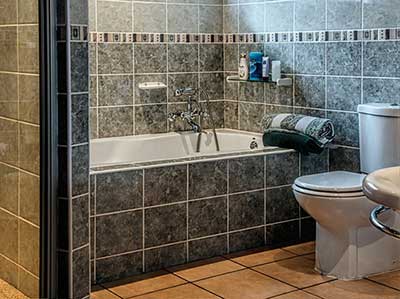You really have to visit one of our weekly auctions to see the diversity of innovative appliances, building materials and carpets on sale in Melbourne. Case in point is the remarkable range of specialty bath tubs.
It used to be that a tub was just a tub. But now there are designer tubs, whirlpool tubs, walk-in tubs and more. The type of material the tub is made from will partly be determined by its use. Common bathtub materials are acrylic, porcelain, marble and fibreglass. Each material has its own properties, and each is a good material in its own way.

Acrylic: lightweight, inexpensive and versatile
The most common bathtub material today is acrylic. A versatile material, acrylic is used in everything from kayaks to airplanes. It won’t fade or stain, it’s easy to mould and shape, and it is used in specialty products like whirlpool tubs. It’s virtually inert, chemically, and is able to withstand drastic temperature changes without cracking. Because the colourant is added during the manufacturing process, it won’t fade and is resistant to ultraviolet light. For these reasons, today’s outdoor tubs are almost exclusively made from acrylic.
Does this stuff have a down side? Well, it scratches easily and its finish is shiny, so scratches show. Scratches can be repaired using fine-grit wet/dry sandpaper, and the shiny finish can be restored using toothpaste or baking soda.
Fibreglass is best for walk-in tubs
Fibreglass is an even stronger material than acrylic. Because it is durable and easy to mould into shapes, fibreglass is often used for walk-in tubs. Fibreglass comes in just about any colour and is less shiny than acrylic. However, the colour is painted on and will fade over time. Fibreglass bath tubs are usually coated with something called gelcoat, which is basically a plastic paint.
Cultured Marble for Luxury
A more expensive option, which is increasing in popularity, is cultured marble. Cultured marble is made by mixing natural marble with a polyester resin. It is finished with gelcoat. Marble tubs come in many shapes, and they usually include a large tub surround. These are great because there are no seams to clean and you never have to repair grouting around tiles.
Looking to go retro?
The most expensive, and probably least practical, bathtub material is porcelain. Porcelain or enamel is applied over cast iron or, less commonly, stainless steel. These are heavy, expensive and unforgiving of scratches or chips. There are a few advantages. The cast iron holds heat very well, for example.
Probably the only time porcelain is appropriate is if you are decorating for a retro look. The old claw-foot tubs are exclusively made of porcelain over cast iron. Because they are so heavy, they are also shorter and narrower than bath tubs made of other materials. You can buy modern versions made out of modern materials, as well.
We sell bathtubs made of all these materials, and you can check out what’s right for you at our Melbourne showroom.
